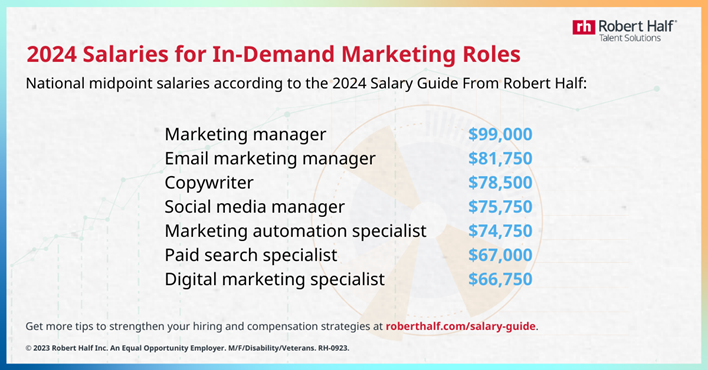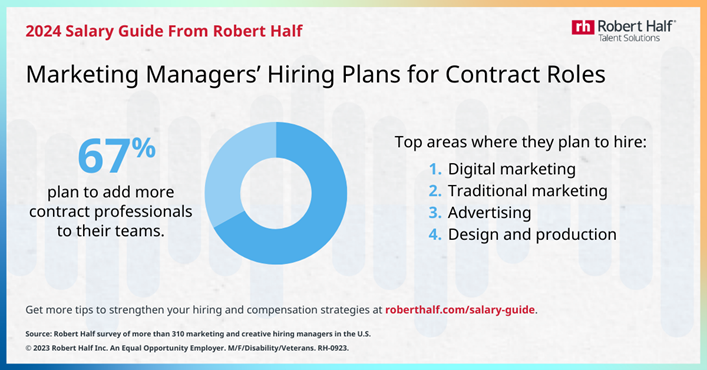Will hiring be any easier in 2024 than it has been over the past few years?
Little is certain, but it doesn't seem likely.
Fully 94% of marketing and creative managers are struggling to find the talent they need, especially in areas like marketing automation and UX design, Robert Half research found.
But the following tips and insights from the 2024 Salary Guide From Robert Half can help you crack the hiring code with the following five tips.
1. Match your rivals' salaries and be transparent
You're not just competing with other firms for customers. You're also all vying for many of the same top-tier candidates in specialized roles. One way to gain an edge: offer industry-standard salaries for key positions.
Here are a few national midpoint salaries for critical marketing positions from the Salary Guide. You can also customize these figures to your local market.

And don't be afraid to offer more where you can. In the high-tech field of digital marketing, specialized skills often command a premium.
Marketing leaders are particularly willing to bump up salaries for skills in marketing automation (36% of managers), digital marketing strategy (33%), and research and analytics (33%). Making better offers to people with essential skills is a strategic move that could boost your company's growth in the long run.
Also, don't leave in-demand candidates guessing about what you're willing to pay. Robert Half's research shows that 42% of workers expect to see salary information up front, and 57% won't move forward with interviews if it's not provided.
Including salary details in your job listings helps candidates make informed choices, saving both sides time.
2. Don't wait—time-to-hire is of the essence
The race for talent is more than just a figure of speech. A full 83% of managers have missed out on securing a strong candidate in the past year, and 29% attribute that to taking too long to make an offer.
Time-saving strategies are critical. Make job postings crystal-clear, specifying work arrangements and must-have skills. Keep applicants informed at every stage to provide a hassle-free, positive recruitment experience.
When you've found the right candidate, don't hesitate—make a competitive offer before that person is snapped up by a rival.
3. Benchmark benefits and perks
Speaking of that competitive offer: Is your complete compensation package appealing to potential employees? A full 41% of marketers say they see benefits as a top consideration when applying for a job. Even if you present top-notch salaries, the difference between a new hire and a missed hire could be beyond the paycheck.
To help you build and retain your team, benchmark your benefits and perks offerings to ensure they match what professionals seek.
Robert Half research shows the benefits workers want most are health insurance, paid time off, and retirement savings plans, whereas flexible work schedules, remote work options, and remote work business allowances lead the pack for desirable perks. Consider whether there are opportunities to expand or enhance your offerings in these areas.
4. Be flexible—it's no fad
Remote and hybrid work options are often the clinchers for marketers deciding between job offers.
For example, 59% of managers say they've had top candidates turn down jobs because remote work wasn't part of the deal. And 65% of marketing professionals would expect a salary bump—a 17% increase, on average—if they had to come into the office every day.
Flexibility also helps with retention: Nearly half (49%) of managers have lost a key employee for lack of remote options.
Developing and communicating flexible work policies could be the edge you need to build the team you want. Whether offering full-time remote work, hybrid models, or simply more flexible hours, spell it out in your job ads and interviews.
5. Try the scalable talent model
A scalable talent strategy pairs contract professionals with permanent staff, giving managers a scalable solution to staffing needs. In fact, 67% of marketing and creative managers plan to lean more heavily on that approach, especially in areas such as digital marketing, traditional marketing, advertising, and design and production.

Adopting a scalable talent model has some clear upsides:
- Quick access to skills. Whether you need specialized skills to start a new project or to kick-start a stalled one, contract professionals offer a fast, expert fix.
- Cost savings. By hiring contract professionals as needed, you turn some fixed employee costs into variable ones, which can save money on hiring, training, and overtime.
- Retention. Offering relief to your permanent staff helps avoid burnout and turnover when workloads are high, and it allows them to focus on high-priority tasks and take time off when needed. For example, if you're a retail or e-commerce firm, consider adding contract professionals to support your team during busy seasons such as holiday shopping.
- Avoiding bad hires. Contract talent keeps projects running while you take your time to find the right full-time employee. Some contract pros might even end up being your next great hire.
To make the most of the scalable talent model, think about teaming up with a talent solutions firm. It can simplify the process of finding and vetting specialized contract professionals.
* * *
Company growth and the need for specialized skills are driving hiring at a time when attracting top marketing talent can feel like navigating an obstacle course. But with the right moves—offering competitive salaries, providing flexible work options, and using contract talent to fill in the gaps—you can pave the way for successful hiring and retention.




